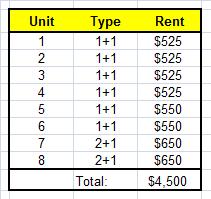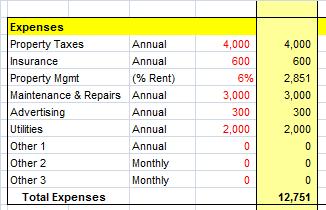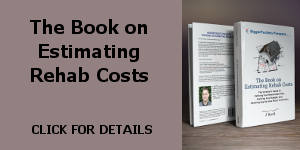Net Operating Income
It’s now time to jump into the analysis. And one of the cornerstone metrics of RE financial analysis is “Net Operating Income” or “NOI” In short, NOI is the total income the property generates (after all expenses), not including debt service costs (loan costs). In mathematical terms, NOI is equivalent to the total income of the property minus the total expenses of the property:
NOI = Income & Expenses
In general, NOI is calculated on a monthly basis using monthly income and expense data, and can then be converted to annual data simply by multiplying by 12. So, now that we know we need NOI, and we know that NOI is calculated using property income and expenses, let’s jump into our income and expense calculations.
Assessing Property Income
Gross income is the total income generated from the property, including tenant rent, other income from such things as laundry facilities, parking fees, etc, and any other income that your property will produce on a regular basis. From our example property, we have 8 units renting for between $525-650 per month, as follows:

Plus, we have $200 per month ($2400 per year) in additional income from laundry facilities in the building, for a total monthly income of $4700 (and annual income of $54,000).
Because the majority of a property’s income generally derives from tenant rent, it is very important that your income calculations take into account the rent you won’t be collecting due to unit vacancy. In any area, there is some average vacancy rate; the vacancy rate for the property you are evaluating may be higher or lower than the surrounding area, and if it is, you need to decide how you’d like to factor that into your analysis.
For example, if building vacancy is listed as lower than average local vacancy, the first question you should ask is whether the data you are looking at is pro-forma or actual? If it’s actual, what is the current management doing to keep the building filled? Is the rent lower than market rents? When do current leases expire? In any regard, you need to determine what you think is a reasonable vacancy rate going forward; my suggestion would be to err on the side of conservative for this, and not assume that your vacancy rate will be any lower than the local average vacancy rate.
So, to assess total income on the property, you want to subtract out the income that you likely won’t see due to vacancy. In our example property, only 7 of the 8 units are listed as vacant (which equates to about 12% vacancy), so we’ll go with that for our analysis. So, our total monthly income for this property would be:

With the total monthly income $4160, the total annual income would be $49,920.
Assessing Expenses
Now let’s calculate our total expenses for this property. In general, expenses break down into the following items:
- Property Taxes
- Insurance
- Maintenance (estimated based on age and condition of property)
- Management (if you choose to employ a professional property manager)
- Advertising (to advertise for tenants)
- Landscaping (if you hire a professional landscaping company)
- Utilities (if any portion of the utilities is paid by the owner)
- Other (anything else we may have missed above)
Any expenses listed as monthly should be converted to annual, and then we can total our expenses to find the annual cost of operating the property:

So, the total annual expenses for this property would be $12,751.
Calculating NOI
Now that we have our total annual income and expenses for the property, we can calculate NOI using the formula above:
NOI = Income – Expenses
= $49,920 – $12,751
= $37,169 (the property generates $37,169 per year)
While NOI doesn’t give you the whole picture (or even enough information to make any decisions), it is the basis for calculating most of the important metrics in our analysis.
In the next section, we’ll examine those key metrics…




Love the way you break it down, since am still learning the ropes and young. Its easier shown like this than a forum of all these numbers and everybody posting.
Its a lot clearer now. Thanks.
great post J. I really love the way you break this down for novice investors. One question and it may seem dumb, but how did you configure the 12% vacancy rate math-wise?
Hey Junior,
12% is the vacancy rate if 1 of the 8 units is vacant at any given time (1/8).